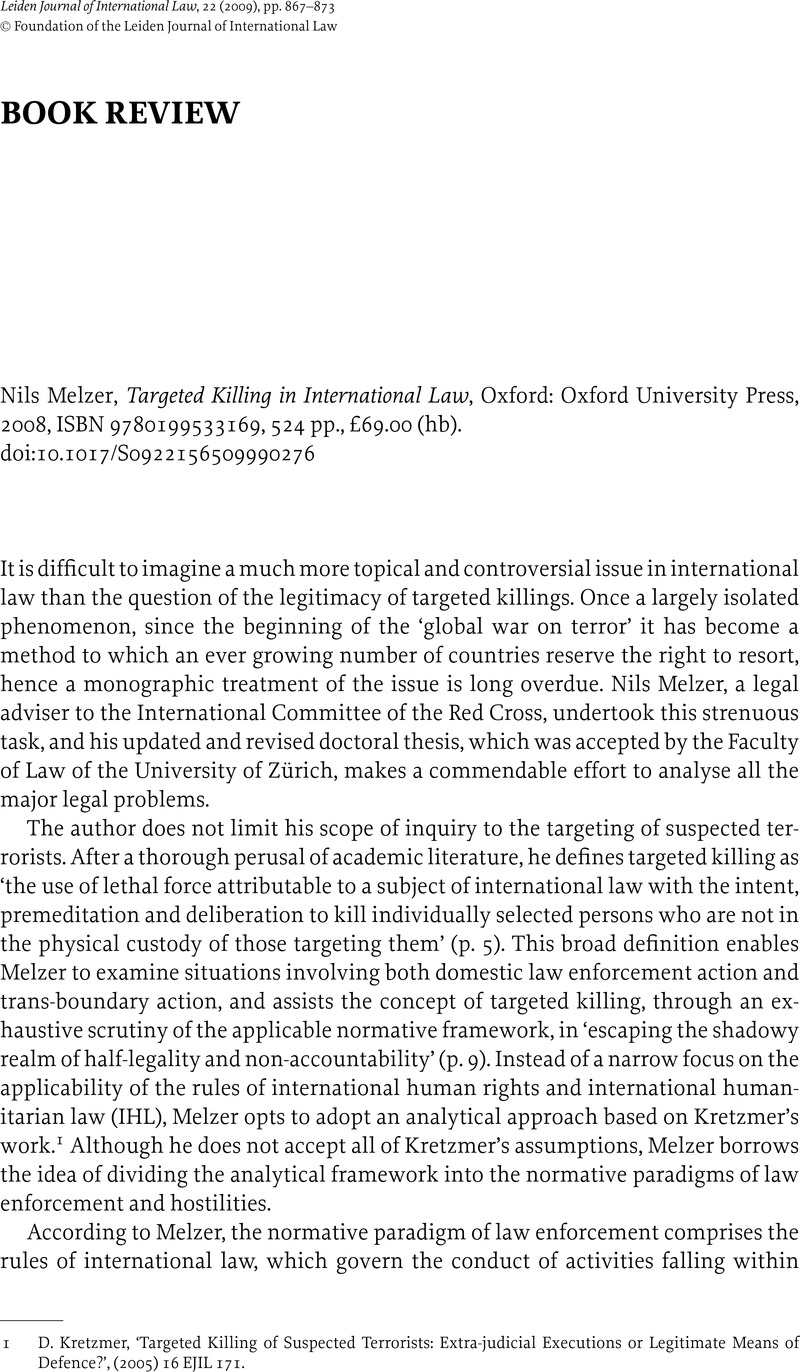No CrossRef data available.
Article contents
Nils Melzer, Targeted Killing in International Law, Oxford: Oxford University Press, 2008, ISBN 9780199533169, 524 pp., £69.00 (hb).
Published online by Cambridge University Press: 28 October 2009
Abstract

- Type
- BOOK REVIEW
- Information
- Copyright
- Copyright © Foundation of the Leiden Journal of International Law 2009
References
1 D. Kretzmer, ‘Targeted Killing of Suspected Terrorists: Extra-judicial Executions or Legitimate Means of Defence?’, (2005) 16 EJIL 171.
2 ‘A civilian taking a direct part in hostilities cannot be attacked . . . if a less harmful means can be employed.’ Public Committee against Torture in Israel v. Government of Israel et al., Decision of 14 December 2006, HCJ 769/02, at 40.
3 Hamiyet Kaplan et al. v. Turkey, Decision of 13 September 2005, [2005] ECHR (Ser. A), at 51–5.
4 Y. Dinstein, The Conduct of Hostilities under the Law of International Armed Conflict (2004), 88.
5 Dinstein, for instance, affirms that ‘[t]he only way for members of the armed forces to immunize themselves from further attack is to surrender, thereby becoming hors de combat.’ Ibid., 94. The major humanitarian law treatises seem to deem it obvious that all military objectives can be legitimately targeted. See inter alia Y. Sandoz, C. Swinarski, and B. Zimmermann (eds.), Commentary on the Additional Protocol of 8 June 1977 to the Geneva Conventions of 12 August 1949 (1987), 635; L. C. Green, The Contemporary Law of Armed Conflict (2000), 191; A. P. V. Rogers, Law on the Battlefield (1996), 33.
6 Isayeva v. Russia, Decision of 24 February 2005, [2005] ECHR (Ser. A), at 191.
7 Al-Adsani v. United Kingdom, Judgment of 21 November 2001, [2002] ECHR (Ser. A), at 55.
8 W. Abresch, ‘A Human Rights Law of Internal Armed Conflict: The European Court of Human Rights in Chechnya’, (2005) 16 EJIL 741.
9 Gaggioli, G. and Kolb, R., ‘A Right to Life in Armed Conflicts? The Contribution of the European Court of Human Rights’, (2007) 37 Israel Yearbook of Human Rights 115, at 124Google Scholar.
10 Y. Dinstein, War, Aggression and Self-Defence (2002), 14.
11 See more in detail T. Hoffmann, ‘Squaring the Circle? International Humanitarian Law and Transnational Armed Conflicts’, in M. J. Matheson and D. Momtaz (eds.), Rules and Institutions of International Humanitarian Law Put to the Test of Recent Armed Conflicts (2009) (forthcoming).
12 J.-M. Henckaerts and L. Doswald-Beck (eds.), Customary International Humanitarian Law, 2 vols. (2005).
13 The ICRC study uses exactly the same argument. In Rule 3 it stipulates that ‘All members of the armed forces of a party to the conflict are combatants, except medical and religious personnel’, and while it affirms that combatant status only exists in international armed conflicts the study still finds useful the notion of ‘combatant’ for purposes of the principle of distinction even in non-international armed conflicts. The study cites as examples GA Res. 2676 (XXV) of 9 December 1970 and the Cairo Declaration and Cairo Plan for Action, adopted at the Africa–Europe Summit held under the aegis of the Organization of African Unity and the European Union on 3–4 April 2000, but admits that treaty provisions use different designations and that therefore it is still difficult to see why any weight should be given to these non-binding documents. Ibid., at 11–13.
14 International Committee of the Red Cross, Interpretative Guidance on the Notion of Direct Participation in Hostilities in International Humanitarian Law, available at www.icrc.org/Web/eng/siteeng0.nsf/htmlall/direct-participation-ihl-article-020609/$File/direct-participation-guidance-2009-ICRC.pdf. Melzer played a significant part in the drafting of the document.
15 ‘Elementary considerations of humanity and common sense make it preposterous that the use by States of weapons prohibited in armed conflicts between themselves be allowed when States try to put down rebellion by their own nationals on their own territory. What is inhumane, and consequently proscribed, in international wars, cannot but be inhumane and inadmissible in civil strife.’ Prosecutor v. Tadić, Decision on the Defence Motion for Interlocutory Appeal on Jurisdiction, Case No. IT-94–1-AR72, Appeals Chamber, 2 October 1995, para. 119. However, it is doubtful that the jurisprudence of the ICTY is completely reliable as evidence of customary international law. See T. Hoffmann, ‘The Gentle Humanizer of Humanitarian Law: Antonio Cassese and the Creation of the Customary Law of Non-international Armed Conflicts’, in C. Stahn and L. V. D. Herik (eds.), Future Perspectives on International Criminal Justice (2009) (forthcoming).
16 Y. Dinstein, C. Garraway and M. Schmitt, The Manual on the Law of Non-international Armed Conflict with Commentary (2006), 35–6.




